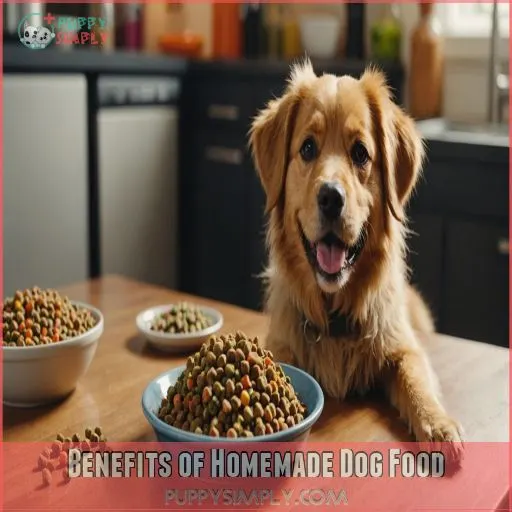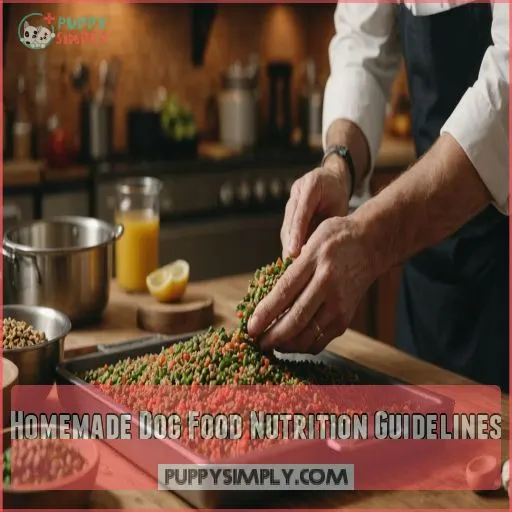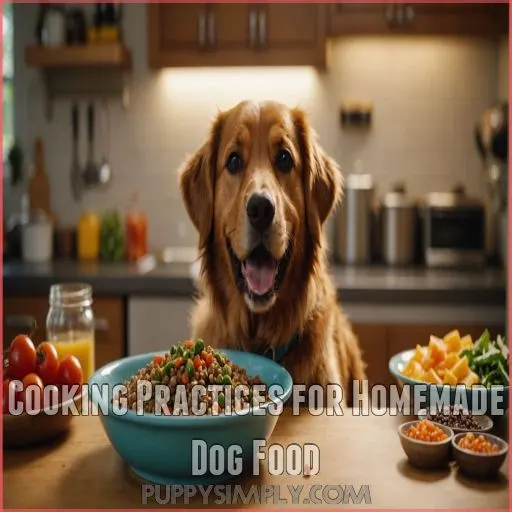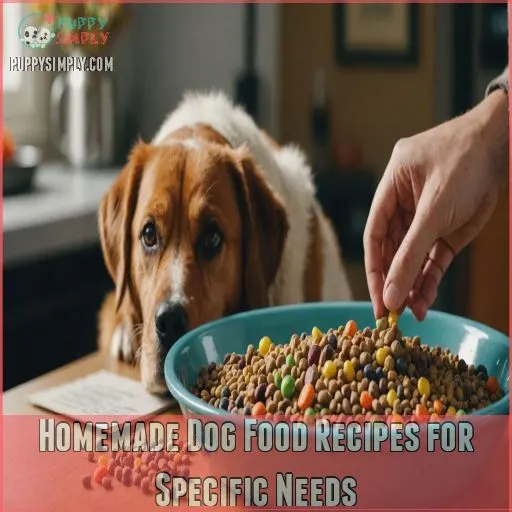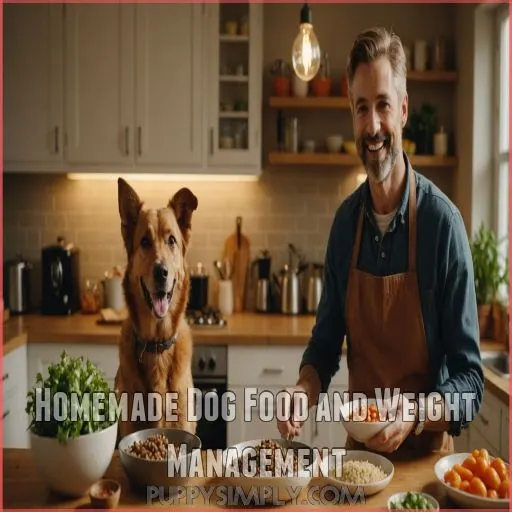This site is supported by our readers. We may earn a commission, at no cost to you, if you purchase through links.
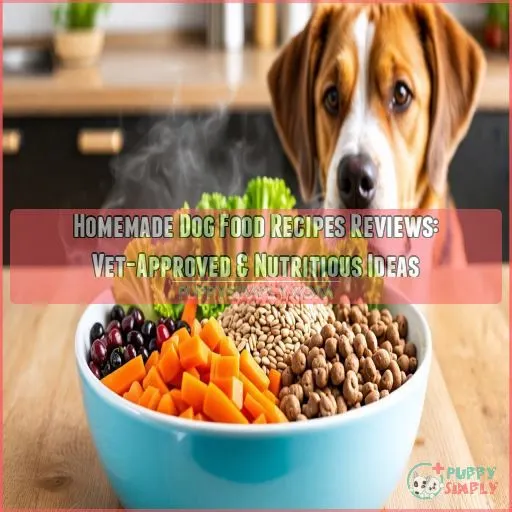
These recipes can help your dog dodge allergies like a pro, live longer, and maybe even avoid that extra trip to the vet.
Letting Fido have a Chicken and Quinoa Feast that’s both tasty and healthy is a great idea. Just be sure to balance nutrients and always run it by your vet.
Who knew homemade meals could pack so much woof-tastic goodness? Stay tuned for more insights on making your pup’s meals right at home.
Table Of Contents
- Key Takeaways
- Benefits of Homemade Dog Food
- Homemade Dog Food Nutrition Guidelines
- Cooking Practices for Homemade Dog Food
- Vet-Approved Homemade Dog Food Recipes
- Homemade Dog Food Recipes for Specific Needs
- Homemade Dog Food and Allergies
- Homemade Dog Food and Weight Management
- Where to Get Started With Homemade Dog Food
- Frequently Asked Questions (FAQs)
- Do vets recommend homemade dog food?
- What should be the main ingredient in homemade dog food?
- Is it worth making homemade dog food?
- What not to put in homemade dog food?
- How to store homemade dog food safely?
- Are supplements necessary for homemade dog food?
- What are common mistakes in homemade dog food prep?
- Can I freeze homemade dog food for later?
- How to transition from commercial to homemade dog food?
- Conclusion
Key Takeaways
- Switching to homemade dog food turns you into your pup’s personal chef, giving you control over the ingredients and helping you manage allergies, weight, and overall health. It’s like giving your dog a VIP meal plan!
- Be sure to chat with your vet to nail down a balanced diet, as homemade meals can sometimes miss essential nutrients. Think of it as tailoring a suit—precision is key to making it fit perfectly!
- Storage is a breeze if you’re organized—airtight containers and a freezer are your best friends here. It’s like preparing for a doggie food bonanza without the fridge chaos.
- Dive into creative recipes like Chicken and Quinoa Feasts or even Blueberry-Banana CBD treats to keep meals exciting. Who knew meal prep could have your pooch wagging its tail in anticipation?
Benefits of Homemade Dog Food
Switching to homemade dog food can boost your pup’s lifespan and help manage their weight.
All while reducing cancer risks and allergies.
Plus, fewer digestive issues mean no more embarrassing tummy rumbles during quiet movie nights!
Increased Lifespan and Health Benefits
Imagine your pup wagging happily into their golden years. Cooking up homemade dog food can help boost their longevity and health.
Consider these benefits:
- Longevity: Fresh diets may extend life by nearly 3 years.
- Digestion: Whole diets improve digestion and nutrient absorption.
- Allergies: Customized meals reduce allergic reactions and skin issues.
Who wouldn’t want more time for love and licks?
Reduced Cancer Risk
Feeding Spot homemade dog food could help reduce cancer risk.
Packed with cancer-fighting ingredients like broccoli and sweet potatoes, these recipes offer more antioxidants compared to kibble.
Processing removes nutrients; hence, a raw dog food diet preserves them.
Swap your pup’s food for a nutritious, tasty cancer prevention diet today!
| Ingredient | Antioxidant Content | Cancer Risk Reduction |
|---|---|---|
| Broccoli | High | Significant |
| Sweet Potato | Medium | Moderate |
| Fish Oil | High | Significant |
Improved Digestion
Switching to homemade dog food can work wonders for your dog’s digestive health.
Unlike kibble, homemade meals allow you to include fiber-rich ingredients and probiotics for dogs, which can ease digestion issues.
You’ll notice fewer tummy troubles and improved regularity. It’s like hitting the sweet spot for your pup’s stomach, avoiding common dog food allergies and ensuring better dog food digestion .
Weight Management and Obesity Prevention
With homemade dog food, weight management becomes approachable and effective.
You gain control over portion sizes and ingredient quality, helping to prevent obesity.
Calorie counting makes it easier to tailor meals to your dog’s needs, ensuring the right serving size for weight loss or maintenance.
Engage in a regular exercise routine and consult your vet for personalized guidance and healthy treats.
Reduced Allergies and Sensitivities
Is your canine companion constantly scratching, licking, or experiencing skin irritation? Homemade dog food may be the solution to their allergy woes.
By crafting customized meals, you can:
- Avoid common allergens like beef, chicken, and dairy.
- Maintain a healthy omega-3/6 ratio to reduce inflammation.
- Eliminate additives and preservatives that can trigger sensitivities.
With a little effort, you can whip up allergy-friendly recipes that’ll have your pup feeling their best.
Homemade Dog Food Nutrition Guidelines
When you’re making homemade dog food, getting the right mix of nutrients is as crucial as remembering your keys before you leave the house.
Your furry friend needs a balanced diet with proteins, fats, carbs, vitamins, minerals, and plenty of water to wag their tail happily and healthily.
Essential Nutrients for Dogs
Imagine crafting a perfect feast for your furry companion.
Dogs need balanced meals with protein sources for muscle growth, fats for energy, and vitamin supplements to thrive.
Don’t forget their mineral needs—like calcium and zinc for bone health.
Consulting a dog food nutritionist makes sure your homemade dog food recipes are spot-on for health, just like learning about nutritional guidelines for Cane Corsos
.
Importance of Water in Canine Diet
Worrying about balancing essential nutrients? Don’t forget water, the rock star of your dog’s diet. It’s not just for slurping; it’s key for overall health.
Here’s how you can make sure your dog stays hydrated:
- Monitor your dog’s water intake.
- Use clean water bowls.
- Watch for dehydration signs.
- Add moisture-rich homemade dog food recipes.
Protein Sources for Homemade Dog Food
When crafting homemade dog food recipes, focus on protein sources like lean meats—beef, chicken, turkey—and fish options.
Plant-based proteins can also be useful for dogs with food sensitivities.
Balance and variety are key. Think of your dog’s diet as a symphony where proteins play the lead role, keeping your furry friend healthy and happy, which is the main lead role .
Fat and Carbohydrate Requirements
Just as protein helps build muscles, fats and carbs play key roles in your homemade dog food recipes.
Consider these factors:
- Fat Percentage: Essential for energy and coat health.
- Carb Ratios: Consider the dog’s age and activity level.
- High-Fat Needs: Active dogs may require more.
- Low-Carb Options: Keep carbs minimal for less active canines.
Vitamins and Minerals in Homemade Dog Food
Adding vitamins and minerals to homemade dog food is like building a sturdy bridge for your dog’s health. Balancing essential nutrients like calcium, vitamin A, and zinc helps avoid deficiencies. Homemade recipes need supplements compared to commercial kibble.
Here’s a quick guide:
| Nutrient | Source | Function |
|---|---|---|
| Calcium | Tofu, broccoli | Bone health |
| Vitamin A | Carrots, liver | Vision, immunity |
| Zinc | Eggs, liver | Skin health |
Balanced meals keep tails wagging!
Cooking Practices for Homemade Dog Food
Cooking homemade dog food takes a bit more effort, but it’s worth it to keep your pup happy and healthy.
Just be sure to cook all ingredients thoroughly and avoid over-supplementing vitamins and minerals.
Your vet can help you get the balance just right.
Cooking Grains, Beans, and Starchy Vegetables
Balancing dog food involves proper cooking techniques for grains, beans, and starchy vegetables.
Start by boiling rice or lentils until tender to make sure they’re easy to digest.
Sweet potatoes, a favorite starch source, become nutritious fuel when cubed and simmered until soft.
This approach combines essential nutrients while adding variety to your homemade dog food recipes, keeping your pup wagging their tail in delight.
Avoiding Over-Supplementation of Vitamins and Minerals
Tackle homemade dog food with finesse by avoiding over-supplementation.
Too much of a good thing can lead to vitamin toxicity and mineral imbalances—definitely not the dog’s dinner you’d hoped for!
Consult your vet to keep those dog food supplements in check and guarantee safety.
Think of it as a nutritional balancing act that promotes wag-tastic wellbeing!
Tips for Food Storage and Safety
Embrace food safety guidelines while crafting homemade dog meals to ensure a nutritious diet for your pet
. It’s like guarding a treasure!
Master these steps:
- Storage Containers: Choose airtight options to extend shelf life.
- Refrigeration Tips: Store food for up to four days.
- Freezing Methods: Freeze individual portions for up to three months to lock in freshness.
Your pup’s meals will be excellent!
Vet-Approved Homemade Dog Food Recipes
You’re probably wondering which homemade dog food recipes are actually good for your furry friend, right?
Vet-approved ones, like the Chicken and Quinoa Feast and Blueberry-Banana CBD-Infused Treats, keep tails wagging but also provide your dog with balanced nutrition.
Chicken and Quinoa Feast Recipe
Have you whipped up a Chicken and Quinoa Feast yet? It’s a dog food recipe that’s both nutritious and easy to make, ensuring your pup gets essential nutrients.
Quinoa is a great source of protein and fiber for dogs.
Here’s a snapshot:
| Ingredient | Amount (g) | Benefits |
|---|---|---|
| Chicken Breast | 350 | High protein |
| Quinoa | 139 | Energizing |
| Spinach | 90 | Fiber |
Enjoy cooking!
Blueberry-Banana CBD-Infused Dog Treats Recipe
Let’s get creative with a blueberry-banana CBD-infused dog treat recipe using rolled oats and explore healthier alternatives for your pet, check out oat-based dog treats wholesome rolled oats
.
Packed with CBD benefits, these homemade treats are perfect for dogs, even those with allergies.
Mixing blueberries and bananas, they’re a delightful snack with healthy recipes your pup will love.
Adjust CBD dosage for different sizes, ensuring safety and control in your homemade dog food recipes.
Vet-Approved Complete Dog Food Recipe
Whipping up a vet-approved homemade dog food recipe is easier than you think.
Start with lean protein like chicken or turkey, add some brown rice or potatoes, and don’t forget those all-important vitamin and mineral supplements.
Your pup will gobble it up, and you’ll have peace of mind knowing they’re getting a nutritious meal .
Homemade Dog Food in the Crockpot Recipe
Imagine turning kitchen chaos into calm with homemade dog food in a crockpot. It’s as easy as pie, really!
- Choose Ingredients Wisely: Opt for lean meats and a mix of veggies.
- Mind the Cooking Time: High for 4 hours or low for 6, stirring occasionally.
- Food Safety First: Cool before serving to avoid any hot mess mishaps.
Healthy Recipes for Busy Dog Owners
Ever wondered how to whip up quick, healthy meals for your pup? Try recipes featuring natural ingredients like ground turkey, brown rice, and spinach. They’re time-saving, budget-friendly, and vet-approved.
Adding the right mix of protein, fat, and carbohydrates, such as those found in bichon frise homemade dog food, can help support overall health and well-being.
Additionally, including essential fatty acids in these meals can promote healthy skin, coat, brain function, and immune system. Add variety with zucchini for a fresh twist.
You can guarantee your dog gets nutritious, homemade meals without breaking the bank or your back.
Homemade Dog Food Recipes for Specific Needs
When you’re whipping up dog food at home, one size doesn’t fit all, especially if your pup’s a senior or still a playful puppy.
Tweak recipes for specific needs like low-calorie, hypoallergenic, or age-appropriate meals, and remember, even dogs love variety—just not in the wardrobe department!
Low-Calorie Dog Food Recipes
Shifting focus from vet-approved meals, let’s chat about managing your dog’s waistline with low-calorie recipes.
Use lean proteins like chicken, with fiber-rich veggies such as broccoli for filling, nutrient-dense options. Control portions to your dog’s needs with handy weight loss tips.
Who said healthy dog food can’t be tasty? Your pup will appreciate these nutritious treats.
Hypoallergenic Dog Food Recipes
Tired of your pup munching on low-calorie kibble?
Switch gears to hypoallergenic dog food to alleviate those pesky allergies. Common allergens may include wheat, soy, and corn.
Try recipe examples using alternative dog food ingredients like sweet potatoes and turkey.
Need a laugh? Even dogs roll their eyes at itchy skin!
DIY allergy tests and vet consultation guarantee a perfect fit.
Senior Dog Food Recipes
Choosing the right senior dog food recipes can feel like a treasure hunt.
Focus on key areas for your aging companion’s health:
- Kidney health: Use lean proteins like fish. A balanced diet can also be achieved with Limited Ingredient Grain Free Dog Food. For instance, incorporating real salmon as a primary protein source can provide essential nutrients.
- Joint support: Add glucosamine supplements.
- Digestive needs: Opt for easily digestible carbs. A diet with fewer ingredients can also help manage allergies and sensitivities, improving digestion and overall health.
- Dental health: Include crunchy veggies for teeth.
Your furry friend’s golden years deserve special care!
Puppy Food Recipes
Crafting the perfect homemade puppy food doesn’t have to be ruff.
Start with high-quality protein like chicken or fish, add complex carbs, and don’t forget those all-important vitamins and minerals.
Follow vet-approved recipes to guarantee your pup gets the balanced nutrition they need for a healthy, happy start in life.
Homemade Dog Food and Allergies
If your dog scratches or sneezes more than your grandpa during allergy season, it might be time to look into homemade dog food.
By identifying food allergies and avoiding common triggers, you can whip up meals that keep your pup itch-free and happy.
Identifying Food Allergies in Dogs
Getting to the bottom of dog food allergies can feel like solving a mystery. With patience, you can pinpoint the culprits.
Look out for:
- Common Symptoms: Ear infections, itchy skin, and digestive troubles.
- Elimination Diet: Gradually remove potential allergens.
- Allergy Testing: Confirm suspicions with your vet.
A dog food overhaul may alleviate pesky symptoms and put your pup at ease (Source).
Creating a Hypoallergenic Diet
Imagine your dog’s relief when you switch to a hypoallergenic diet.
By using dog food recipes that focus on grain-free options and ingredient swaps, you’re addressing common dog allergies like itchy skin.
Don’t forget allergy testing and diet elimination to pinpoint specific triggers.
Homemade dog food gives you control over dog food ingredients for a happier, healthier pup, like tailoring meals to specific needs
.
Avoiding Common Allergens
When crafting homemade dog food, sidestepping common allergens like beef, chicken, and dairy can help you manage dog food sensitivity.
Embracing hypoallergenic treats can keep your pup’s tail wagging.
Opt for dog food that’s gluten-free, grain-free, and xylitol-free for safer choices.
Remember, even dogs need a varied menu to avoid monotony and surprises.
Homemade Dog Food and Weight Management
Keeping your dog at a healthy weight is as important as tracking your own calorie intake, but who knew chicken and rice could work wonders for them too?
Homemade dog food gives you the chance to tailor nutrients precisely, helping manage weight effectively and keeping your pup spry and ready for that next game of fetch.
Maintaining a Healthy Weight
Balancing Rover’s diet is key to maintaining a healthy weight.
Keep an eagle eye on portion control and remember, those pleading puppy eyes don’t need extra treats!
Swap high-calorie goodies for healthy ones, like carrot sticks.
Homemade dog food recipes can offer precise nutrients while managing costs.
Partner with your veterinarian to make sure your homemade meals meet your dog’s needs.
Weight Loss Strategies for Dogs
Ready to help your pup shed a few pounds? Homemade dog food can be a great weight loss strategy, and considering a grain-free diet may be beneficial for dogs with sensitivities or allergies. For example, a grain-free diet like the Bravo Canine Cafe Turkey Fricassee can be a healthy choice.
Focus on lean proteins, complex carbs, and fiber-rich veggies.
Portion control is key, use a food scale and measure portions carefully. And don’t forget daily exercise to keep your canine companion fit and healthy!
Managing Obesity in Dogs
To help your fluffy friend shed pounds, consider vet-approved homemade dog food recipes.
Think of it as a canine spa day—without the cucumber slices!
Emphasize exercise, calorie control, and portion sizes. Consult your vet to tailor meals using cooked, raw, or BARF diets.
And remember, even treats should fit within this new wagging regimen.
Where to Get Started With Homemade Dog Food
Starting homemade dog food can feel like a walk in the park—with the right steps. You’ve just tackled your pup’s weight management, now let’s roll up our sleeves!
First, consult your veterinarian to make sure balanced nutrition, considering key ingredients like animal protein which should constitute 50-75% of their diet animal protein sources. Choose ingredients rich in essential nutrients, like ground turkey and spinach. Browse reliable recipes from trusted sources that fit your dog’s needs.
Using a dog food blender or slow cooker save time and enhance flavors. Gradually switch your dog to homemade meals by mixing them with their regular kibble to prevent tummy troubles. Homemade meals can be cost-effective and designed for safety.
- Watch your furry friend thrive with fresh meals.
- Say goodbye to mysterious ingredients.
- Enjoy quality time cooking for your dog.
- Create meals that match their needs perfectly.
Frequently Asked Questions (FAQs)
Do vets recommend homemade dog food?
Diving into homemade dog food might sound like an epic adventure.
Most vets recommend sticking with high-quality commercial diets.
Homemade options often lack balance and nutrients unless formulated with a veterinary nutritionist’s help to ensure they are balanced and nutrients, .
What should be the main ingredient in homemade dog food?
Protein should be the main ingredient in homemade dog food, providing essential amino acids for your pup’s health.
Good protein sources include lean meats, poultry, and fish.
Check with your vet to make sure the recipe is balanced and meets your dog’s needs, specifically providing the necessary essential amino acids.
Is it worth making homemade dog food?
Cooking for your furry friend could be worth it if you’re after control over ingredients and nutritional needs.
Homemade meals can tackle allergies and provide variety.
Balanced nutrition is important to make sure, as referenced in.
Homemade meals can be a good option for your pet, but they require careful planning to ensure your pet’s health.
What not to put in homemade dog food?
When whipping up homemade dog food, steer clear of toxic ingredients like onions, garlic, chocolate, and xylitol.
These can harm your pup.
Consult a vet nutritionist to make sure your recipe’s safe and balanced.
How to store homemade dog food safely?
Is your pup’s food safe and sound?
Store it in airtight containers for 5-7 days in the fridge or up to 3 months in the freezer.
Reheat meals before serving and make sure they’re fresh.
Are supplements necessary for homemade dog food?
Switching your dog to homemade food often requires supplements to guarantee balanced nutrition.
Essential nutrients like calcium, vitamin D, and omega-3s might be missing otherwise.
Always chat with your vet to tailor the diet right (Source).
What are common mistakes in homemade dog food prep?
Crafting homemade dog food can seem tricky, but here’s the scoop: balance nutrients like protein and calcium, avoid toxic ingredients like grapes and xylitol, and stick to vetted recipes.
Use safe, healthy ingredients for your furry friend.
Can I freeze homemade dog food for later?
Yes, you can freeze homemade dog food to keep it fresh for future meals.
Just portion it out, label the containers with a date, and freeze.
When needed, thaw in the fridge overnight for safe consumption.
How to transition from commercial to homemade dog food?
I know it can seem overwhelming, but switching your pup to homemade food is easier than you think.
Start slow, mix in their favorite treats, and check with your vet to make sure the switch is smooth and healthy (Source).
Conclusion
Imagine your dog doing a happy dance with every bite of their homemade meal.
You’re not just a chef in the kitchen; you’re crafting a healthier life for your pup.
Homemade dog food recipes, especially those vet-approved, help sidestep allergies, manage weight, and boost health.
Have fun experimenting, knowing you’re offering the best for your furry friend. Check with your vet, and watch your dog’s tail wag away after every bite.
Who knew mealtime could be this rewarding?

